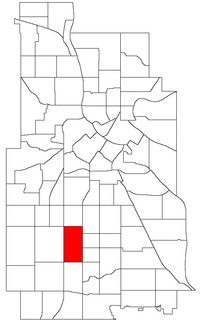King Field, Minneapolis facts for kids
Quick facts for kids
King Field
Kingfield
|
|
|---|---|
|
Neighborhood
|
|

Location of King Field within the U.S. city of Minneapolis
|
|
| Country | United States |
| State | Minnesota |
| County | Hennepin |
| City | Minneapolis |
| Community | Southwest |
| Founded | 1849 |
| Named for | William S. King |
| City Council Ward | 8 |
| Area | |
| • Total | 0.828 sq mi (2.14 km2) |
| Population
(2020)
|
|
| • Total | 7,576 |
| • Density | 9,150/sq mi (3,532.7/km2) |
| Time zone | UTC-6 (CST) |
| • Summer (DST) | UTC-5 (CDT) |
| ZIP code |
55409
|
| Area code(s) | 612 |
| Historical population | |||
|---|---|---|---|
| Census | Pop. | %± | |
| 1980 | 8,443 | — | |
| 1990 | 7,884 | −6.6% | |
| 2000 | 7,816 | −0.9% | |
| 2010 | 7,473 | −4.4% | |
| 2020 | 7,576 | 1.4% | |
King Field (also known as Kingfield) is a lively neighborhood in the Southwest part of Minneapolis, Minnesota. It's bordered by 36th Street to the north, Interstate 35W to the east, 46th Street to the south, and Lyndale Avenue to the west. Inside the neighborhood, you'll find a park named after the famous civil rights leader, Martin Luther King Jr..
King Field is part of Ward 8 in the city. This area is currently represented by Minneapolis City Council member Andrea Jenkins.
Contents
A Look Back: King Field's History
The King Field neighborhood gets its name from Colonel William S. King. It's located in Minneapolis's Southwest community. The neighborhood's edges are Interstate 35W on the east and Lyndale Avenue on the west. To the north is 36th Street, and to the south is 46th Street.
In 1885, the city of Minneapolis ended at 38th Street. But by 1887, the city grew bigger, reaching 54th Street. This is how the area we now call King Field became part of Minneapolis. King Field is mostly a place where people live. About three-quarters of its single-family houses were built before 1920. The neighborhood has many helpful places like churches, schools, the park named after Martin Luther King Jr., and lots of small businesses.
How the Neighborhood Grew
In the second half of the 1800s, this area was mostly farmland. People traveled by horse and buggy. By 1874, fewer than 20 farms were set up. For example, C.C. Garvey had a dairy farm near 44th Street and Grand Avenue. George Bichnell farmed about 18 acres of land between Lyndale and Pleasant Avenues, from 42nd to 43rd Streets. Hiram Van Nest farmed about 28 acres from 40th to 42nd Streets, between Pleasant and Lyndale. The Farmsworth farm was a large 57-acre property south of 47th Street and east of Nicollet.
The area between Lake Street and 40th Street was mostly built between 1903 and 1914. Many homes were in the Colonial Revival style or were Craftsman bungalows. After World War I, the land south of 40th Street and north of Minnehaha Creek was developed. The Church of the Incarnation opened in 1918 at 38th Street and Pleasant Avenue. This church was added to the National Register of Historic Places in 2022. It is also a special historic district for the city of Minneapolis.
Street Stories: How They Got Their Names
Ever wonder how streets get their names? Here's how some streets in King Field got theirs:
- Blaisdell Ave. was named for Robert Blaisdell, Sr., and his three sons. They were early settlers and worked with lumber on the Mississippi River.
- Garfield Ave. is named after James Garfield, a U.S. president who was sadly assassinated.
- Grand Ave. comes from a French word meaning "great" or "noble."
- Harriet Ave. is named after Harriet Lovejoy. She was the wife of Colonel Leavenworth. (Lake Harriet is also named after her!) Colonel Leavenworth was the first leader of a temporary fort called Fort St. Anthony in 1819.
- Lyndale Avenue is named after the huge 1,400-acre Lyndale farm. This farm belonged to William S. King and was near Lake Harriet and Bde Maka Ska. The farm's name honored Mr. King's father, Rev. Lyndon King.
- Pleasant Ave. is named because it was a pleasant place!
- Pillsbury Ave. honors Governor John Pillsbury. He was the Governor in 1875 and served for three terms. He also helped build up the state university and gave money for one of its main buildings.
- Wentworth Ave.
- Van Nest Ave. is named after Hiram Van Nest. He was one of the first people to settle near Saint Anthony Falls, which is where Minneapolis began. He bought a lot of land when Minneapolis was first opened for settlement.
- Nicollet Avenue remembers Joseph N. Nicollet. He was a geographer and explorer. His maps of the area, which is now Minnesota and parts of North and South Dakota, were published in 1843.
- Stevens Ave. is named after Colonel John H. Stevens. He was an early pioneer in the city. He built the first permanent house in Minneapolis in 1850.
Learning in King Field: Local Schools
King Field is home to several schools for students of all ages:
- Barton Community School (Kindergarten to 5th grade), located at 4237 Colfax Ave S, Minneapolis 55409.
- Lyndale Community School (Kindergarten to 5th grade), located at 312 West 34th Street, Minneapolis, MN 55408.
- Justice Page School (6th to 8th grade), located at 1 West 49th Street Minneapolis, MN 55419.
- Washburn High School (9th to 12th grade), located at 201 West 49th Street, Minneapolis, MN 55419.
- Lake Country Montessori School (Kindergarten to 8th grade), located at 3755 Pleasant Ave S, Minneapolis, MN 55409.

